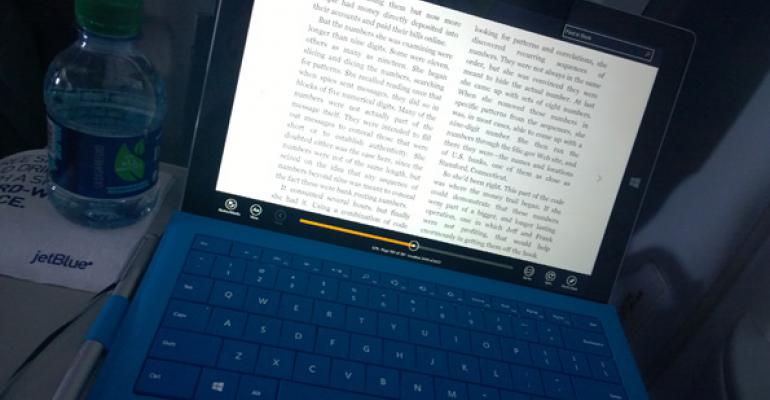For Surface Pro 3 to succeed as a tablet, it needs a superior reading experience. And while this isn't fully Microsoft's fault, Surface Pro 3 does comes up a bit short because of its large size and a few software-related issues. It works, but it's not ideal
You can think of this as a chicken and egg type problem. Surface Pro 3 benefits mightily from the improvements Microsoft has made since the original release of Windows 8, first with Windows 8.1 and then more recently with Windows 8.1 Update 1. Likewise, it benefits from the ever-maturing Modern (formerly "Metro") ecosystem: Today, there are far more apps and services available through this system that was the case a year ago.
As you might expect, however, the available reading software varies. Some of it is excellent, and Surface Pro 3 ships with a number of great reading apps—which are part of Windows—including Bing News, Finance, Food & Drink Health & Fitness, Sports, and Travel, plus Reading List and Reader—not to mention Internet Explorer 11, which features an excellent Reading View.
Reader is a bit of a hidden gem. It's your basic PDF reader, and supports a variety of useful views, such as the ability to view two pages side-by-side, which is usually quite readable on Surface Pro 3's big, high DPI screen.

That's a nice chunk of functionality out of the box. But beyond that, you can find a number of popular reading apps in the Windows Store, including Flipboard, News Bento, the Onion, and so on. There is also a reasonable collection of good newspaper apps, including high-profile options like The New York Times, The Wall Street Journal, USA Today and many others.
Where the reading experience falls apart, sadly, is with e-book reading apps, or perhaps more specifically with Amazon Kindle. All of the major players are represented—Kindle, Nook, Kobo and more—but of course Kindle is the dominant player. And the Kindle app for Windows isn't great.
There are a number of issues with the app, but the big one is that it only support books, including at least the limited range of graphical novels and comics I've purchased. But good luck finding a newspaper or magazine that works in this app. With Kindle for iPad, I get my full collection, but with Kindle for Windows, I can only read a subset.

Oddly enough, Amazon's Kindle Cloud Reader works well with Surface Pro 3, and you can pin books with this solution and then read them offline. But there's no huge benefit in doing so: Cloud Reader doesn't provide access to periodicals either. (And I can't get Cloud Reader to display text in two columns in landscape mode, despite an awkwardly named option that is supposed to enable this functionality.)

(There's also a Kindle desktop application, which I've not installed on Surface Pro 3 only because I recently tried it on a different device. It's oddly old-school, but has no real advantage to speak of.)
All things being equal, the Barnes & Noble Nook app is a vastly superior reader, and unlike Kindle it supports periodicals. But Barnes & Noble has stopped working on this app, making it kind of a lame duck until and unless a rumored Microsoft Nook-compatible reader app appears. And Nook can't help if you've got a sizable Kindle investment, as I do.
Physically, Surface Pro 3 isn't an ideal reader of course. There's a reason so many people use phablets and mini-tablets—not to mention dedicated e-book readers—for this use. And if you compare the size of a Surface Pro 3 to a full-sized iPad Air and an iPad mini, you can clearly see the problem. Surface Pro 3 is comparatively humongous.

iPad mini (top), iPad Air (middle) and Surface Pro 3 (bottom)
Surface Pro 3 is also thicker and heavier than today's iPads, obviously. Some have tried to make the case that Surface Pro 3 is just about the same weight as the original iPad, as if that settles the matter. But that device came out four long years ago. We must judge this device on its contemporary competition, not the past.
On the other hand, the very point of Surface Pro 3 is that it can replace both a tablet and a laptop. And if you wanted to, you could absolutely travel or commute with only this device and use it as a reader on your way to some destination. Likewise, reading around the home is comfortable enough.
It's just big. It's big like a large type book one with a vision impairment might buy. And like a Kindle DX, I'm sure there's some market for such a solution. But it's still a bit awkward, especially in the portrait reading mode that many would prefer.
Landscape mode works better in some ways, in part because of the kickstand, which I love, and especially if you use a reading app that supports two column text or a two page view. If you can sit it on a table or other surface, it works well because you don't have to hold it up.
Ultimately, this little exercise yielded no surprises for me: I already knew the Kindle app for Windows was terrible, and anyone who has spent time reading on a smaller device will understand why the experience is better. But Surface Pro 3 does have a great screen and some good and very good reading app, and it can certainly do the job if you want to just use the one device.





